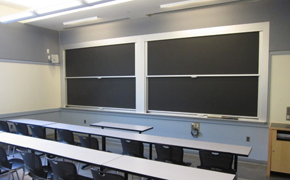Instructor Insights pages are part of the OCW Educator initiative, which seeks to enhance the value of OCW for educators.
Course Overview
This page focuses on the course 21L.703 Studies in Drama: Stoppard and Company as it was taught by professor Diana Henderson in Spring 2014.
This course is an intensive study of the works of one of Britain’s most respected, prolific and funny dramatists, Sir Tom Stoppard, and some of his contemporaries. It explores a wide range of knowledge in fields of math, philosophy, politics, history and art in order to think about the medium of drama as well as one writer’s work in depth. We analyze how drama connects with both the culture it represents and that which it addresses in performance.
Course Outcomes
Course Goals for Students
In addition to participating in the fun of reading Tom Stoppard & Co., there are seven course objectives outlined on the syllabus page.
Curriculum Information
Prerequisites
Two previous literature courses.
Requirements Satisfied
CI-M ![]()
Offered
Every other spring semester
Assessment
The students' grades were based on the following activities:
 30% Reading, class participation and contribution, including watching films, providing feedback, and other events
30% Reading, class participation and contribution, including watching films, providing feedback, and other events 20% Reports and class leadership
20% Reports and class leadership 10% Focused single-play analysis
10% Focused single-play analysis 15% Self-assessments, scene and other writing
15% Self-assessments, scene and other writing 25% Major analytical essay/project
25% Major analytical essay/projectStudent Information

Enrollment Cap
12
Breakdown by Year
Mostly junior and senior undergraduate students and occasionally grad students.
During an average week, students were expected to spend 12 hours on the course, roughly divided as follows:
In Class/Seminar
- Met 2 times per week for 1.5 hours per session; 26 sessions total; mandatory attendance.
- Student-led discussion of readings and films.
- Three sessions included exchange and discussion of an essay with a partner.
- Three subsequent sessions involved class discussion of partner essay ideas.
- The last two sessions were student presentations on the major project.
Out of Class
- Completed readings, watched films.
- Prepared seminar questions and discussions based on the readings and films.
- Completed self-assessments, essays, Stoppardian scenes, and reports.
- Attended MIT DramaShop’s production of Arcadia.
Semester Breakdown
| WEEK | M | T | W | Th | F |
|---|---|---|---|---|---|
| 1 |  |  |  |  |  |
| 2 |  |  |  |  |  |
| 3 |  |  |  |  |  |
| 4 |  |  |  |  |  |
| 5 |  |  |  |  |  |
| 6 |  |  |  |  |  |
| 7 |  |  |  |  |  |
| 8 |  |  |  |  |  |
| 9 |  |  |  |  |  |
| 10 |  |  |  |  |  |
| 11 |  |  |  |  |  |
| 12 |  |  |  |  |  |
| 13 |  |  |  |  |  |
| 14 |  |  |  |  |  |
| 15 |  |  |  |  |  |
| 16 |  |  |  |  |  |
 No classes throughout MIT
No classes throughout MIT Class session
Class session Attend MIT DramaShop's production of Arcadia
Attend MIT DramaShop's production of Arcadia
 Self-assessment, essay, report, or Stoppardian scene due
Self-assessment, essay, report, or Stoppardian scene due No class session scheduled
No class session scheduled Exchange and discussion of partner essays
Exchange and discussion of partner essays Student presentation of major project
Student presentation of major project

 Room 1 of 1
Room 1 of 1 